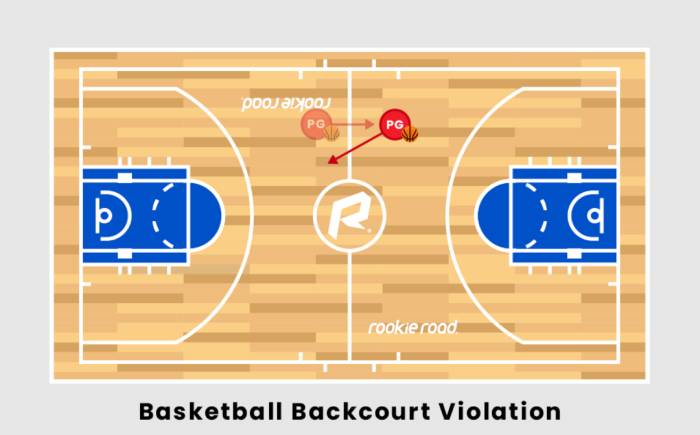Backcourt violations occur when the offensive team commits an infraction in their own half of the court. It refers to two minor infractions that keep the game’s pace exciting and equalize scoring opportunities. The following is a complete breakdown of a basketball backcourt violation.
Table of Contents
What is the Backcourt?
A team’s backcourt is its defensive zone or the half where their basket is located. Meanwhile, the frontcourt is the offensive zone or half around the opponent’s basket. The home team’s logo is usually displayed in the center of the court to help separate the two teams.
What are the Two Types of Backcourt Violations in Basketball?
One of two infractions usually occurs when a team commits a backcourt violation. Over-and-back violations or fouls lasting eight or ten seconds occur.

What is the Eight Second Violation in Basketball?
The eight-second rule is the first violation of the backcourt rule. A team possessing the ball must dribble from the backcourt to the frontcourt within eight seconds. Only professional leagues, such as the NBA or FIBA, are subject to this rule.
Teams have 10 seconds to cross the halfcourt line in the NCAA, WNBA, and high school basketball. The eight-second rule or ten-second rule is commonly referred to as the backcourt violation rule.
What is the Over and Back Violation in Basketball?
Due to the fact that teams have to cover so much ground in such a short period of time, some players may feel pressured to pass frequently. A player with control of the ball is restricted from passing where they want due to the over and back violation. The ball cannot be passed back into the backcourt once a team passes the halfcourt line and establishes frontcourt status.
What are the Reasons a Backcourt Violation Call Won’t Occur?
It is possible for teams not to receive a backcourt violation in some cases. A foul, for instance, may give players more time to reach halfcourt with the ball if time is stopped. If a team throws the ball inbound at center court, they may pass it to a player in their backcourt without violating the rules. As a result of a foul, this throw is a throw-in during a basketball game.
What Happens When a Team Commits a Backcourt Violation?
Backcourt violations are relatively mild in comparison to other infractions during a basketball game. A backcourt violation stops the game time, and the offensive team relinquishes control of the ball to the defensive team. After receiving the ball, the receiving team can begin its offensive drive at the halfcourt line.
Why Are Backcourt Violations Important in Basketball?
Basketball relies heavily on backcourt violations to encourage offensive possession and scoring. If these plays weren’t in place, offensive players could pass anywhere they wanted, allowing defensive teams to be spread thin.
How Do Teams Draw up Defensive Plays in the Backcourt?
By implementing defensive strategies that limit passing opportunities, specific teams take advantage of the over and back rule. Half-court and full-court traps are examples of these. In these schemes, defensive players block or trap offensive players in their backcourt, limiting the number of teammates they can pass to.
Using these defensive schemes can force offensive players to take risky shots at the basket or attempt passes that would result in backcourt violations. It is an excellent way for players to defend their half of the court since these plays often result in turnovers.
What is the History of the Backcourt Violation?
As the 10-second rule uses the shot clock, many fans assume it came after major basketball leagues adopted it. However, that isn’t the case. In 1933, the 10-second rule was adopted by the NBA (the shot clock was not adopted until 1954).
Originally, the ten-second rule was called the “time line,” which meant that you had a specific amount of time to pass the halfcourt line. FIBA changed the backcourt violation rule from 10 seconds to 8 seconds in 2000, and the NBA followed suit a year later.
What is the History of the Over and Back Rule?
Over and back rules have been in practice in professional basketball for a long time. A number of adaptations have also been made to protect the flow of the game.
If a defensive player hits the ball into a team’s backcourt, an offensive player can retrieve it without penalty. Referees have some discretion when it comes to the over and back rule, unlike the eight-second rule. If an official feels that a call isn’t warranted, they can miss it or waive it.
Does the WNBA, NCAA, and High School Still Use the 10-Second Rule?
There is a 10-second rule in the WNBA, NCAA, and high school basketball. The shot clock is used today to count the ten seconds, which helps fans and referees determine how much time remains before a violation occurs. Since this rule follows the shot clock, and everyone can see it, players and refs rarely miss the call.
Conclusion: What is a Backcourt Violation in Basketball?
In basketball, the two rules that fall under the category of backcourt violations are put in place to encourage teams to make more offensive plays. Even though these violations do not result in free throws, they can have severe consequences for groups.
When a player or team commits a backcourt violation, they lose control of the ball. Teams on defense have a great opportunity to change the pace of the game when they give up the ball.
Observe how long it takes a player to cross midcourt with the ball and where he passes next time you watch basketball. Maybe you’ll catch a backcourt violation yourself!
